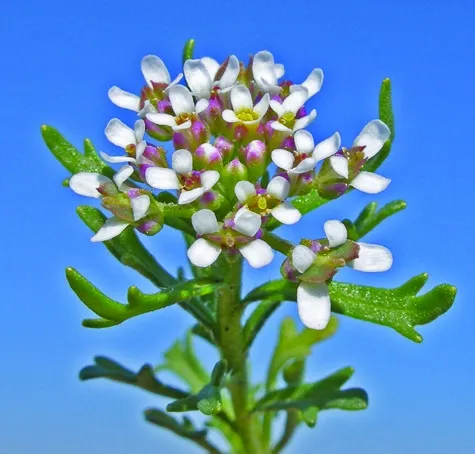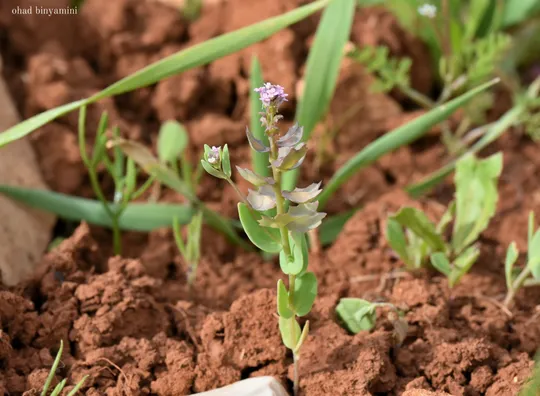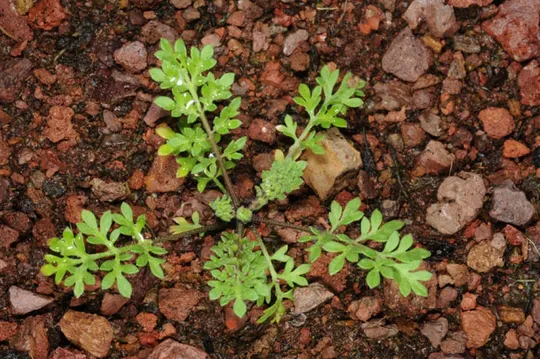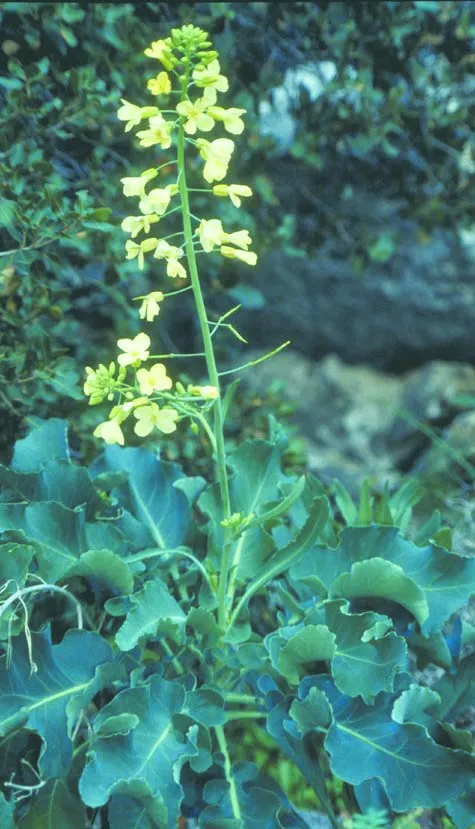Petiolate Garlic Mustard, Jack-by-the-hedge
Alliaria petiolata
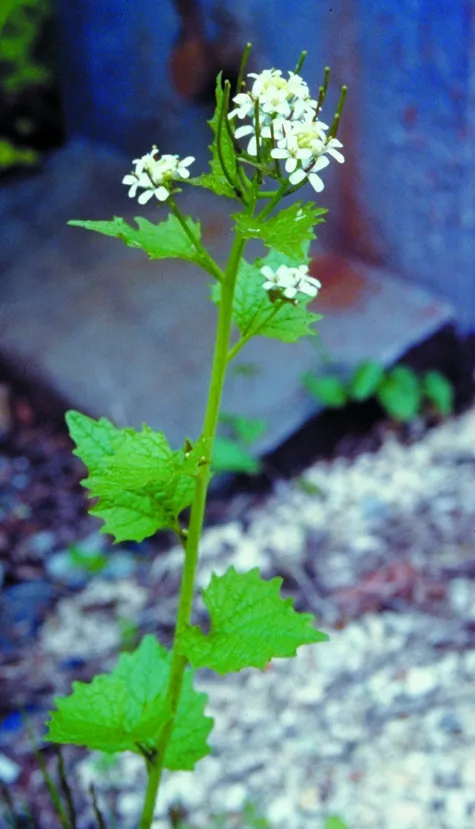
Alliaria petiolata is an annual or biennial herb, 20-120 cm tall, erect or slightly branched, which gives off a garlicky scent. The lower part of the plant stem is purplish, slightly hairy with kidney-shaped leaves, toothed to emarginated with a petiole up to 15 cm long. The upper part of the stem is smooth, the upper leaves are larger and their petiole is shorter than those of the lower leaves. The leaves are triangular or oval and their margins are toothed to emarginated. The inflorescence is a raceme with white 7-8 mm long flowers. The fruit is a 5-7 cm long pod (with about 16 seeds), perpendicular or diagonal to the inflorescence axis. The pod's two valves open from the bottom upward. There are four keels along the fruit. A. petiolata blooms from April to June.
The leaves and stems of Alliaria petiolata are used as an
alternative for garlic and as a salad herb. Ground seeds are used to prepare a
spice that tastes like mustard.
Grows only in the northern Golan. Was discovered in 1987 by Yair or at a
single location in the Mount Avital volcanic crater. Danin (2004) notes herbarium
data from Jerusalem. This is apparently a random occurrence, because in Europe,
Alliaria is considered an invasive plant of disturbed habitats.
On Mount Avital, the species grows at an altitude of 1100 m with
precipitation of 1000 mm, on northern-facing slopes on soil of volcanic origin,
at the edges of dense woodlands of Quercus calliprinos and Q.
boissieri. It grows in cool, shaded habitats throughout its global range.
The genus Alliaria belongs to the Sisymbrium tribe (a taxonomic category that ranks above
genus and below family or subfamily) in
the Brassicaceae family, and the genera close to it are Sisymbrium,
Descurainia and Arabis. The genus itself includes five species in
temperate areas of Europe and Asia. Alliaria petiolata is the most
common of the species in the genus.
·
Alliaria petiolata grows in Israel in only one
location, which constitutes its primary threat, as it can become extinct in
case of harm to the Mount Avital crater woodland.
·
Grows in a single patch in a single location. Its
regional distribution in the Levant is characteristic for a northern plant
species, whose populations become smaller and more fragmented the farther south
they move (Brown, 1984). Therefore, they are severely threatened by extinction.
·
The species has a broad distribution and extends its
range as an invading plant in the American continents; consequently, it is not globally
endangered.
·
Mount Avital is a declared nature reserve.
To complete the declaration process of the Mount Avital crater as a reserve (the northern
northeastern facing slopes), to include the special woodland where the species
is located, together with the unique northern plant species that it includes.
Alliaria petiolata is widely
distributed most of the Europe and the northern Mediterranean Sea basin, as
well as in North Africa (the Maghreb countries). The species grows in the
Irano-Turanian region in Iran, northern Iraq, Afghanistan, Pakistan, and the
Himalayas and on to central Asia. In the eastern Mediterranean basin, it is rare
and disjunct in Cyprus, northwestern Syria and in Lebanon. The southernmost
point where it was collected in Lebanon is the Beirut area. The plant was
introduced to North America, where it now spreads uncontrollably and is considered
an invasive plant and a noxious weed.
Alliaria
petiolata is a plant
that grows in Israel in a single location. It is very rare because of its
strong affinity for rainy, cool and shaded habitats, which are very rare in
Israel. This is also the cause of its unmistakable peripherality in Israel. The
species is not endangered on a global level, but preservation efforts should be
considered for the unique location in the Mount Avital crater.
Alliaria is an example of the accepted policy
in the world today for nature preservation on a countrywide scale: the country
must prioritize preservation on a global scale (when the species within its
borders is endemic) and on a regional, countrywide scale. On this level, the
fact that a species is very common outside of the borders of the country is not
taken into consideration; rather, the red parameters within the specific
country are considered. Therefore, even though Alliaria is a very common
species and a spreading ruderal plant in Europe – it is important to protect
the single population found in Israel and to prioritize it for preservation.
כהן,ע., הלר, ד. ואור,י. 1988, אליאריה שומית Alliaria petiolata – מין חדש בארץ – מהגולן. רתם 28: 65-72, הוצאת החברה להגנת הטבע.
אתר אינטרנט: http:
/www.nps.gov/plants/alien/fact/alpe1.htm
Current Occupancy Map
| 1000 squre meter pixel | 5000 squre meter pixel | 10000 squre meter pixel | |
|---|---|---|---|
| number of observations | 0 | 0 | 0 |
| in total pixels | 0 | 0 | 0 |
| Family | Brassicaceae |
| Classification | On the endangered species list |
| Ecosystem | Mediterranean |
| Chorotype | Euro-Siberian – Mediterranean and western Irano - Turanian |
| Conservation Site | Crater Mount Avital |
| Rarity |
1
6
6
|
|---|---|
| Vulnerability |
0
0
4
|
| Attractiveness |
0
0
4
|
| Endemism |
0
0
4
|
| Red number |
1
3.7
10
|
| Peripherality | N |
| IUCN category | DD EW EX LC CR EN VU NT |
| Threat Definition according to the red book | Vulnerable |
 Based on:
Based on:
